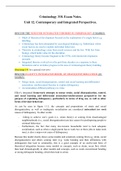Criminology 310. Exam Notes.
Unit 12. Contemporary and Integrated Perspectives.
DISCUSS THE NEED FOR INTEGRATED THEORIES IN CRIMINOLOGY (5 MARKS)
Much of theoretical development focused on the explanation of a single factor e.g.
labelling.
Criminology has been dominated by sociological thinking e.g. Sutherland, where
social factors are used to explain individual behaviour.
Theorists in criminology come from social sciences and the law. With few from
biology which holds value for the discipline.
Criminology theory became Stagnant in the 1970s with limited developments
onwards.
Integrated theories evolved over the past three decades as a response to these
limitations and to revitalise progress in the area of criminological theory building.
(Read page 141 for a general overview)
DISCUSS ELLIOTT’S INTEGRATED MODEL OF DELINQUENT BEHAVIOUR (10
MARKS)
Merge strain, social disorganization, control and social learning and differential
association- reinforcement theories to explain delinquency
Accommodates different pathways to crime
Elliot’s integrated framework attempts to merge strain, social disorganization, control,
and social learning and differential association-reinforcement perspectives for the
purpose of explaining delinquency, particularly in terms of drug use, as well as other
forms of deviant behaviour.
As can be seen in figure 11.1, the concepts and propositions of strain and social
disorganization, as well as inadequate socialization are considered antecedent (or root)
causes of delinquency. In other words:
- failing to achieve one’s goals (i.e., strain theory) or coming from disadvantaged
neighbourhoods (i.e., social disorganization) are key causes for predisposing people to
criminal behaviour.
- Furthermore, the fact that many low-income households tend to lack adequate
socialization, such as when a single parent has to work two or three jobs to make ends
meet, is also a major root cause of delinquency.
Because this model clearly shows some models and constructs coming first (e.g. strain, social
disorganization) and others coming later (e.g. weak bonding and then affiliations with
delinquents) that lead to criminality, this is a good example of an end-to-end form of
theoretical integration because some models or concepts, such as strain, occur first, which
then lead chronologically to other models and concepts, such as weak conventional bonding
or strong delinquent bonding, which then lead to crime.
, The notable ways in which this perspective becomes a true integrated model is seen in the
mediating or intervening variables. Although some antecedent variables (such as strain) can
lead directly toward delinquent activity, most of the criminal activity is theoretically
predicted through a process that would include a breakdown of conventional bonding (i.e.
social control and bonding theory), which occurs in may individuals who experience strain or
social disorganization in their neighbourhoods along with inadequate socialization.
Furthermore, individuals who have such a breakdown in conventional bonding tend to be
more highly influences by the associations that they make in the streets among their peers
(i.e. differential association-reinforcement and social learning theory). According to Elliot’s
integrated theory, this factor – strong delinquent bonding – most directly results in delinquent
behaviour among most juvenile offenders.
One of the most notable features of this theoretical model is that it allows for various types of
individuals to become criminal. In other words, unlike traditionally separate frameworks that
assume offenders expect not to achieve their goals (e.g. strain theory) or come from bad
neighbourhoods (e.g. Chicago or social disorganization theory), Elliot’s integrated theory
allows for a variety of possibilities when it comes to casual paths that explain how crime and
delinquency develop in certain people and groups. This is what makes integrated models so
much more powerful; namely, they bring several valid explanations together and allow for
various possibilities to occur, all of which explain some criminality. Whereas traditional
theories largely provide for only one casual process, Elliot and his colleagues showed right
from the first major integrated theory that different types of trajectories, or paths to crime, are
possible.
One of the major criticisms of merging such theories, particularly strain (which assumes
individuals are born relatively good) and control or social bonding (which clearly assumes
that people are born relatively bad) is that they tend to have extremely different, even
opposite assumptions of human behaviour.
DISCUSS BARITHWAITE’S THEORY OF REINTEGRATED SHAMING (10 MARKS)
Merges bonding and labelling with elements of strain, subculture, gang and DA
theories.
Draws on practices in japan to use imprisonment sparingly; offenders are not labelled
(criminal record) but are reintegrated following apology, compensation and
forgiveness.
The Japanese are less confrontational with authority; they accept the authority of the
law and see the police as ‘elder brothers’ who rely on positive rather than negative
reinforcement.
Focuses on young, poor, single males who live in urban communities with high
residential mobility; poor attachment to school and parents and low occupational
aspirations (strain theory)
Interdependency = level of bonds with conventional society (work, family, faith)
Communitarianism = macro interdependency
Demographic variables … urbanisation …interdependency … communitarianism
Formal ceremony to reintegrate offender (as opposed to stigmatisation and labelling).




